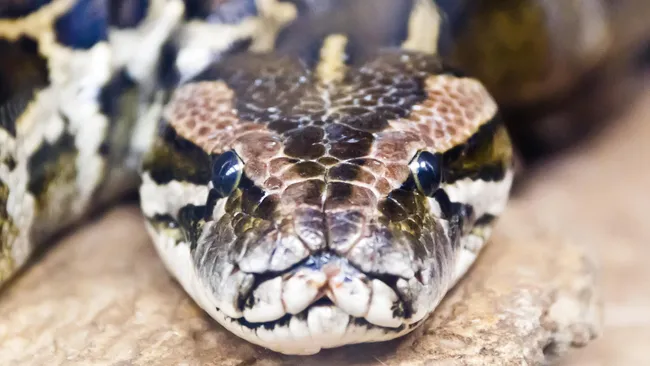Specialized cells in the intestinal lining of Burmese pythons allows them to completely absorb the skeletons of their prey.
Bone-Digesting Cells Found in Burmese Pythons Reveal How Snakes Manage Calcium Overload
Researchers have uncovered specialized cells in the intestines of Burmese pythons (Python bivittatus) that help them process and regulate calcium absorbed from the bones of their prey — shedding new light on how these snakes digest whole animals.
The discovery, published June 25 in the Journal of Experimental Biology, explains how pythons manage the large quantities of calcium they ingest when consuming birds and small mammals whole — bones included.
Burmese pythons are ambush predators that can go weeks without eating. When they do feed, they swallow their prey whole and take several days to digest the meal. Bones provide a crucial source of calcium, but the snakes must prevent excess calcium from building up in their bodies.
“We wanted to identify how they were able to process and limit this huge absorption of calcium through the intestinal wall,” said study co-author Jehan-Hervé Lignot, a biologist at the University of Montpellier in France.
To investigate, the team fed Burmese pythons three different diets: whole prey (containing bones), boneless prey, and boneless prey with added calcium supplements. After several meals, the researchers examined the effects of each diet on the snakes’ intestinal linings.
They found that snakes fed whole prey or calcium-supplemented meals had narrow, specialized intestinal cells containing microscopic particles rich in calcium, phosphorus, and iron. These mineral particles were completely absent in snakes fed boneless prey alone.
The researchers believe these cells help the snakes manage excess calcium by trapping it in these particles and eventually expelling them through feces — a mechanism that prevents harmful calcium buildup in the bloodstream.
Interestingly, similar calcium-holding cells have now been found in other snake species, including boas, and even in Gila monsters (Heloderma suspectum) — all animals that swallow their prey whole. However, researchers haven’t yet observed these cells in other whole-prey eaters like dolphins or fish-eating birds.
The findings open up intriguing possibilities for future research.
“Marine predators that eat bony fish or aquatic mammals must face the same problem” of excess calcium, Lignot said. “Birds that eat mostly bones, such as the bearded vulture (Gypaetus barbatus), would be fascinating candidates too.”
As scientists continue to study this digestive adaptation, they may discover that this mechanism is more widespread across the animal kingdom than previously thought.
